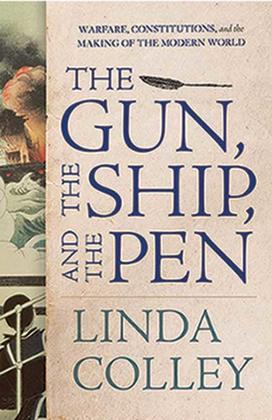Faculty Book: Linda Colley Considers the Constitution
Several factors ‘contributed to the rise of constitutions, but the main one was a dramatic increase in ... warfare.’
Americans are proud of their Constitution, which is 233 years old and the longest surviving written constitution in the world. But as Linda Colley shows in her new book, The Gun, the Ship, and the Pen: War, Constitutions, and the Making of the Modern World (W.W. Norton), the U.S. Constitution emerged during a period when constitution writing flourished around the globe, aided by revolutions in warfare, globalization, and communications. Colley, the Shelby M.C. Davis 1958 Professor of History, spoke with PAW about why constitutions are made, why they fail, and how ours is doing.

There had been rules of law and of government since ancient times. But if you define a constitution as a single document that contains constraints on government and is widely disseminated among the public, those sorts of texts go up after 1750, from Corsica to Sweden. It didn’t begin in 1787. This is not to say that the American Constitution is not remarkable, but it was operating against a sympathetic background.
Several factors around this time contributed to the rise of constitutions, but the main one was a dramatic increase in the scale of warfare. With wars becoming larger and more expensive, there was much more pressure on states to reorganize themselves so they could raise the taxes and the manpower needed to fight them. At the same time, the people, the subjects, said that if the state was going to make more demands on them, they wanted clearly defined rights in return. So this pressure from above and below provided an engine of these rather different constitutions that emerged.
Are countries still writing constitutions?

They are still passing them, and they are amending them. Amendment is crucial and it is arguably one reason why the Norwegian Constitution of 1814, the second-oldest surviving constitution after the American one, has remained effective. Conversely, one could argue that the difficulty involved in amending the U.S. Constitution — as distinct from the state constitutions, which are amended much more often — is one of the structural challenges the United States now faces. The Founders made it difficult to amend the Constitution because they thought that frequent changes might endanger stability, but the American Constitution is now very old. Perhaps it needs to be amended more, though how on Earth do you engineer that in the political environment we have now?
Why do some constitutions endure but most do not?
It is partly contingency. If the United States had been bordered by powerful enemies after 1787, its Constitution probably would not have lasted very long. Hawaii in 1840, when it was an independent monarchy, and Tunisia in 1861 introduced written constitutions in the hope that the imperial powers would respect them as modern states and spare them from colonization. But in neither case did it work.
What is unique about the American Constitution?
I would focus on three things. First, the American Constitution emerged from an epic military struggle that received worldwide attention, which gave the constitution that followed that war a particular international resonance.
Second, it is a very short constitution. That may sound facetious, but it’s not. For a constitution to become well known in all corners of society, it has to be printed and published. That is much easier when you have a short constitution. Constitutions have gotten longer and longer. Look at the Indian constitution; it’s a wonderful document, but it’s huge.
The third distinguishing characteristic of the American Constitution is that the press was so well established in America at the time it was adopted. As soon as the draft was issued in Philadelphia in September 1787 it was picked up all over the new United States, then sent across the Atlantic to Great Britain, which had an even bigger print industry and the world’s biggest maritime fleet, and so it was publicized around the world. Even apart from its specific provisions, the American Constitution had several particular advantages working for it.
How healthy is the American Constitution today?
There’s an old cartoon in Victorian Britain where a bishop asks a junior minister for whom he has made breakfast, “How is your boiled egg?” And the junior clergyman, not wanting to offend, says, “It’s very good — in parts.” I think you could say the same about the American Constitution. Clearly it’s a formidable document, it trains a certain kind of legal vigilance as a way of monitoring government, and it acts as a source of national unity even though we know Americans have never read it and don’t know what’s in it.
But it is a constitution drafted in the 1780s. The Bill of Rights is also very old, not least in regard to gun laws and how those have been interpreted. This gets back to the old question: Are written constitutions too rigid? Remember, Thomas Jefferson thought that for a healthy polity, constitutions should be renewed every 17 or 18 years. But of course politicians don’t have the time or the will. We’d all go mad.
So, it’s good in parts — like the egg.
Interview conducted and condensed by M.F.B.











1 Response
Norman Ravitch *62
4 Years AgoConstitutional History
Well, at least my mentor at Princeton, Robert Palmer, would have loved this book. Some reviewers at Amazon.com thought the book dry; well, constitutional history can be dry. But Robert Palmer, in his Age of the Democratic Revolution, gave the subject before and during and after the French Revolution a good deal of important emphasis.